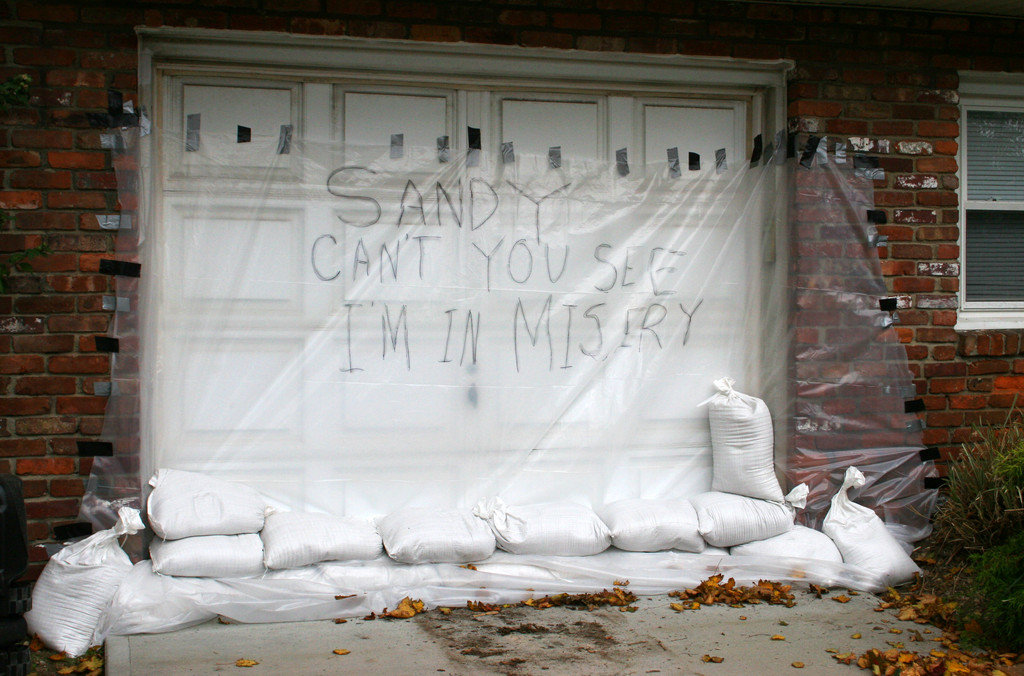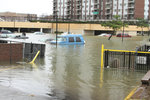Superstorm Sandy, 10 years later
Those who were here as the waters rose recall the devastation and its aftermath
On the morning of Oct. 30, 2012, after the worst storm in a century the previous night had savaged Long Beach, most of the city was basically a dirty brown river.
Cars were buried in sand. Others floated by homes. Mattresses and other household furniture drifted down streets. Power was gone. Treasured family albums lay at the bottom of three to five feet of water, in soaked backyards and on ruined front porches.
To Rich De Palma, then a Long Beach Police Department patrol sergeant, now an inspector, the scene was surreal as he drove around the city the morning after the storm.
“The city was a mess,” De Palma said last week. “I remember the high waters,” he said. “I was seeing water everywhere.”
But it was all real. Long Beach had been slammed by what came to be known as Superstorm Sandy, which began as a tropical wave in the Caribbean Sea that Oct. 22, strengthened to a tropical storm in a few hours and then into a hurricane, and began zeroing in on the Eastern Seaboard. Early on Oct. 29, Sandy struck New Jersey and barreled into New York City and its suburbs. In all, the storm hit 24 Eastern states. In New York, flooded streets forced the closing of tunnels and bridges, and prompted an alarmed Mayor Mike Bloomberg to plead with residents to evacuate.
Long Beach was among the hardest hit areas of Nassau County. The Atlantic Ocean and Reynolds Channel met squarely at City Hall downtown. The boardwalk, the city’s most iconic structure, was all but destroyed. Several homes in the Canals section burned to the ground.
Then-City Manager Jack Schnirman ordered a 7 p.m. curfew on Oct. 29. Incredibly, the city reported no fatalities as a result of the storm, but 44 people were injured. A total of 47 people were killed in New York City.
Scott Kemins, Long Beach’s fire chief and building commissioner, said this week that more than 1,000 homes in the city were deemed “substantially damaged” — meaning unlivable — by the Federal Emergency Management Agency. Then-Gov. Andrew Cuomo’s Office of Storm Recovery awarded $343 million to Long Beach, mostly to owners of single-family homes. Kemins said that New York Rising offered some homeowners as much as $350,000 to repair or elevate their damaged homes.
“We were crippled after Sandy,” Kemins said. “I gained new respect for Porta Potties.” There were 30, he said, at Kennedy Plaza, outside City Hall.
While no one who was in Long Beach on Oct. 29, the following day or in the weeks and even months that followed is likely to forget the devastation, there are also memories of help and hope.
Police officers and firefighters helped people out of their ruined homes. The Red Cross arrived with water, food and blankets. The National Guard was soon on hand. The city set up an emergency tent outside City Hall, where more food and water was handed out.
The Martin Luther King Center, in the largely Black North Park neighborhood, was also feeding “hundreds,” according to then board chairman and community leader James Hodge.
Hodge’s own home was deluged by about five feet of water. He and his parents were unable to get out, and spent the night of Oct. 29 clutching one another as they all tried to sleep on the living room couch.
But, Hodge said, “The whole city of Long Beach was in such dire need.” The MLK Center was turned into a rescue center, and provided residents with food, an operation that continued for weeks.
“I will never forget any of that,” Hodge said.
The rebuilding began rapidly. Homeowners had to scout around for building contractors, who had more work than they could handle. The city mandated that homes that were repairable be raised, in the hope of avoiding another such disaster in the future. U.S. Sen. Chuck Schumer “moved heaven and earth” to secure a generator the size of a tractor-trailer to restart the city’s water and sewer plants, Schnirman recalled in an interview at the time.
The 2.2-mile-long boardwalk was a disorienting sight. It was ripped into pieces by Sandy. It was rebuilt at a cost of about $40 million, reinforced by concrete and resurfaced in Brazilian hardwood. More than 2,700 new trees were planted around the city. FEMA covered 90 percent of the cost, and New York state funded the remainder.
Nassau County officials estimated that of Long Beach’s approximately 33,000 residents, some 15,000 to 20,000 chose not to leave during Sandy.
Sam Pinto, a city firefighter and a member of the Long Beach school board, was among them. He was preparing his house for the storm before the winds became too strong and he had to swing into action. He helped set up the emergency rescue facility at City Hall. The Fire Department also made use of the city’s antique trolley as a temporary shelter for those injured or ill.
“We had no power and we had no sewage,” Pinto recalled. “Everyone was working 24/7.”
Crystal Lake, who lives in North Park, had also decided to stay in the city. She recalls the water rising, but, like others, she had not evacuated during Hurricane Irene in 2011.
Sandy, Lake soon discovered, was worse.
“We began to panic” as the water rose, she recounted. “The water began to rise to the windows.” Many homes in the North Park section are only yards from Reynolds Channel. There was soon a foot of water in Lake’s house. She began to pray. The water stopped coming. “God answered my prayers,” she said. But she was unable to get gasoline for her car, so drove around the city for days “on fumes.”
There are still houses, here and there, left unrepaired, their damage from Sandy still visible. But by and large, a decade later, Long Beach has recovered. There are still — there will always be — recollections of the water and the winds. But there is also much talk about the way people helped each other out of a crisis.
DePalma, the police inspector, asked what he recalled of that time, said, “The people were great. Strangers helped strangers. That was proof there was still a community out there.”











